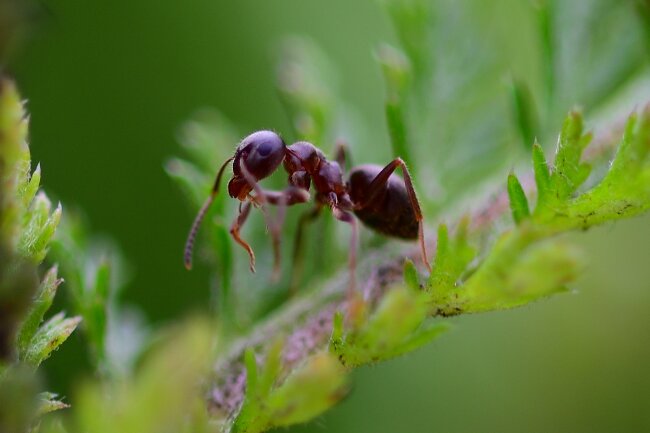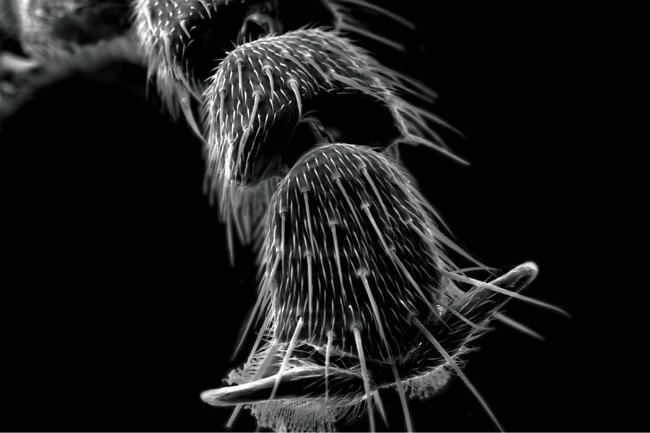Ants do carry diseases, however, these are not transferable to humans. Where they can cause problems is by walking through food and bringing contaminants with them. However, it is very unlikely that a human would become ill because of the presence of ants, unless they are allergic.
Contents
Dangerous insects

In general, insects are highly beneficial to our society. We may only notice them when a noisy fly is buzzing around our room, or when plagues of locusts strip our fields, but the majority of the time they are simply getting on with their jobs helping to pollinate our food, churn our soils and feed our wildlife.
However, there are some insects in the world that are highly dangerous. In rare cases, this is because of the insect itself, because of venom it carries. Though in general deaths are rare from poisonous. Most poisonous insects only have levels sufficient to kill prey roughly their own size, and even those with stronger venom do not aim to bite humans, as this would be a waste of their resources.
When it comes to dangerous insects, it tends to be more the things they carry that affect human health. The mosquito for example kills around 700,000 people a year, largely from spreading malaria, yellow fever, Zika and a number of other harmful illnesses. The Tsetse fly is another culprit, with over 10,000 cases of African sleeping sickness reported a year from this flies bite.
However, not all insects are capable of passing illnesses directly to humans. In general, this occurs when the insect bites a human, usually in order to drink their blood. During the exchange, some of the disease gets into the human’s blood and then develops.
Zoonosis is the process of the disease being passed from an animal species to a human. This does occur, most commonly when humans eat infected meat, but occasionally simply through contact. It is most common from closely related species, such as primates, from domesticated animals or from wild animals that are hunted for their meat.
Zoonosis between humans and insects is rare in species that do not bite humans. While ant species can bite, this is more of a nip, using their mandibles to pinch the flesh. They do not suck human blood or go out of their way to bite them unless they are defending their nests.
Also read: Wondering “If Ants Have Blood?” What is Hemolymph?
Do ants carry disease?

Ant diseases are perhaps some of the most studied in the insect world, as ants themselves are so well studied. Living in an eusocial structure, with many individuals in close proximity, the spread of disease is a real risk in ant colonies.
| Ant Species | Associated Diseases |
|---|---|
| Pharaoh Ants | Salmonella, Staphylococcus, Pseudomonas |
| Fire Ants | Allergic reactions, secondary infections |
| Argentine Ants | Food contamination, transmission of pathogens |
| Carpenter Ants | No known direct disease transmission |
| Bullet Ants | Venomous sting, severe pain |
In order to prevent one sick individual from infecting the whole nest, ants have a variety of methods for containing the spread of disease. Depending on the species of ant, some colonies choose to kill ants that have become sick. Some studies have shown ants can even detect that the individual is ill before they show external signs of sickness.
In other species, sick ants will avoid entering the nest, spending more time outside in order to avoid infecting others. Ants of certain species even have dedicated undertakers, who will remove the dead and place them in a midden away from the nest.
Ants aren’t entirely unkind to the ill or dying, however. It has been found that nestmates will take injured ants back to their nest to recuperate. They may also clean sick ants more thoroughly to try and help remove any diseased particles on their bodies.
Also read: Answering “Do Ants Bury Their Dead?” (Explained)
Dirty feet

The main way that ants are likely to spread illness to humans is through their feet. Ants are notorious for being able to get into wherever they want to. What usually attracts them is food. This could be food intended for eating or simply waste food.
Unlike humans, ants do not feel squeamish about slightly mouldy supplies, or even at more unappealing bodily liquids. Ants will therefore happy to walk through a range of contaminated items before wandering across food intended to be eaten, potentially traipsing bacteria onto things we are about to enjoy.
| Disease | Symptoms | Transmission |
|---|---|---|
| Salmonella | Diarrhea, fever, abdominal cramps | Contaminated food or water |
| Staphylococcus | Skin infections, respiratory issues | Direct contact, contaminated surfaces |
| Pseudomonas | Skin infections, respiratory issues | Direct contact, contaminated surfaces |
| Allergic Reactions | Swelling, itching, hives, anaphylaxis | Ant stings, exposure to ant venom |
| Secondary Infections | Infection of ant bites or stings, delayed healing | Scratching or improper wound care |
| Food Contamination | Contamination of stored food | Ants coming into contact with food |
| Transmission of Pathogens | Carrying and spreading disease-causing organisms | Direct contact, contamination of surfaces |
In general, the likelihood of this leading to illness is low. As soon as we see ants on our food, we are likely to throw it out, or possibly clean it. Large parades of ants are also hard to miss, and most homeowners will quickly remove the ants and clean the surfaces where they have been.
Ants are also relatively clean individuals, regularly cleaning things off the outside of their exoskeleton in order to avoid becoming ill themselves. They will also avoid most liquids or very sticky substances, as they risk becoming stuck or drowning. The likelihood of a human becoming ill because of what an ant stepped in is therefore very slim.
Ant allergy
Most people are familiar with the severe reactions some individuals can have to bee stings, however, few are aware that a small percentage of the population can have a similar reaction to ant stings.
In general, ants do not go out of their way to sting humans. Often, even if threatened, they are more likely to nip or bite. Because different ants have different compositions in their venom, allergic reactions may usually only happen to certain species.
| Preventive Measures | Description |
|---|---|
| Proper food storage and hygiene | Seal food containers, clean spills promptly |
| Effective waste management | Dispose of waste properly, maintain cleanliness |
| Ant exclusion measures | Seal entry points, remove attractants |
| Personal protective measures | Avoid contact with ants, wear protective clothing |
| Regular pest control inspections and treatments | Seek professional pest control if necessary |
As well as a reaction to a sting, some people can have breathing problems when ants are present. Only a handful of cases has been recorded, and have mostly been connected to pharaoh ants, however, it seems the presence of large numbers of ants in a household can lead asthma sufferers to have an attack.
Horrifying ants
We may be quick to paint all kinds of insects in a scary or horrifying light, but in reality, the large majority of the time the presence of ants will not cause any health issues for humans. They may be inconvenient and at times rather irritating, but they certainly aren’t an insect group that’s going to be on a global most wanted poster any time soon.

